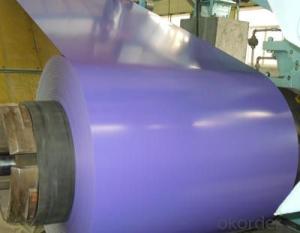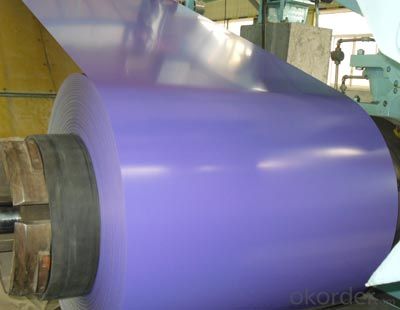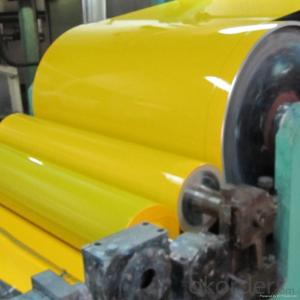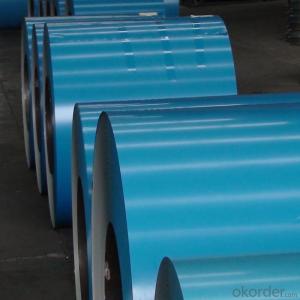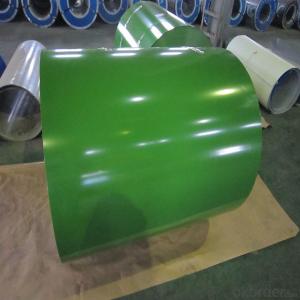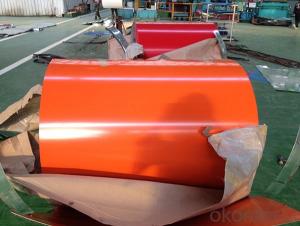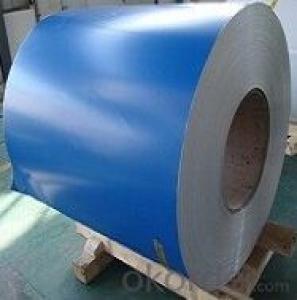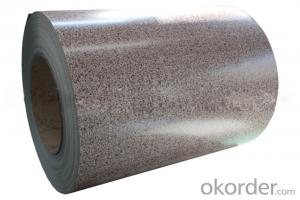Prepainted Aluminum Zinc Rolled Coil for Roof Construction
- Loading Port:
- Shanghai
- Payment Terms:
- TT OR LC
- Min Order Qty:
- 25 m.t.
- Supply Capability:
- 30000 m.t./month
OKorder Service Pledge
OKorder Financial Service
You Might Also Like
Structure of Aluminum Zinc Rolled Coil

Description of Aluminum Zinc Rolled Coil
Aluminum zinc coils is a kind of coated steel coil/sheet. With the cold rolled steel of different strength and thickness as substrate, it is produced through applying Al-Zn coat on both faces by hot dip process. In its coating, Al accounts for about 55%, Si 1.6%, while the remaining is Zn. Aluminum zinc coils enjoys both the physical protective feature and durability of Al and the electrochemical protective property of Zn. And its surface has bright silver color and regular embossed-like figure, which are highly decorative.
Main Feature of Aluminum Zinc Rolled Coil for Construction Roof
1.Corrosion resistance: It mainly depends on the aluminum protection. When the zinc being worn, the aluminum will form a dense layer of aluminum oxide, resist corrosion material to prevent further corrosion inside.
2. Heat resistance: Aluminum zinc alloy steel sheet has excellent heat resistance, can withstand high temperatures over 300 centigrade, and is similar with aluminized steel high temperature oxidation resistance. It often used in chimney pipes, ovens, fluorescent lighting device and the device cover.
3. Heat reflective: Galvanized steel plate heat-reflective high rate is twice as galvanized steel, often used to make insulation materials.
4. Economy: Because density of 55% AL-Zn is smaller than the density of Zn, so in the same weight and thickness of Galvanized zinc layer, aluminum-zinc steel plate is larger area more than 3% of galvanized steel sheet.
Applications of Aluminum Zinc Rolled Coil for Construction Roof
1. Construction and building: roofing; ventilating duct; handrail; partition panel;etc.
2. Electric appliance: refrigerator; washing machine; refrigerator; DVD;etc.
3.Transportation: oil tank; road sign; etc.
4.Agriculture:barn; etc.
5.Others:vending machine; game machine; etc.
Prepainted Aluminum Zinc Rolled Coil for Construction Images
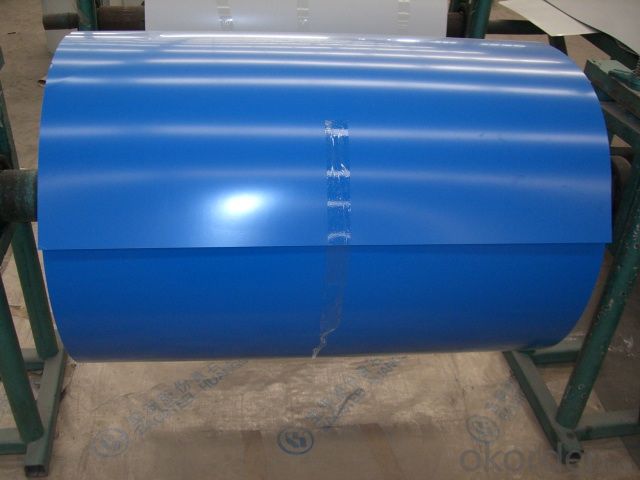
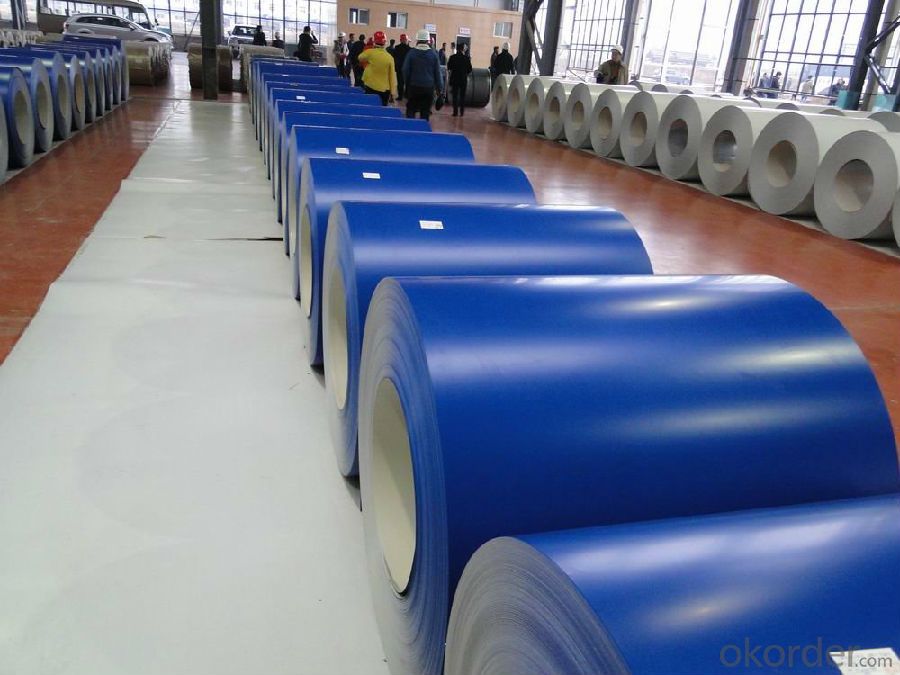
Specifications of Prepainted Aluminum Zinc Rolled Coil for Construction
Surface Treatment | Feature |
Chemical Treatment | minimize the chance of humid-storage staining forms a dark gray surface discoloration on the surface |
retain the bright metallic luster for a long period | |
Oil | minimize the tendency for humid-storage stain |
Chemical Treatment and Oil | The chemical treatment provides very good protection against humid-storage staining, while the oil provides lubricity for operations. |
Dry | must be transported and stored with special precautions to preserve low-humidity conditions. |
Anti-finger print | minimize the chance of humid-storage staining forms a dark gray surface discoloration on the surface |
FAQ of Prepainted Aluminum Zinc Rolled Coil for Construction
We have organized several common questions for our clients,may help you sincerely:
1. What is the minimum order quantity ?
Our MOQ is 50mt for each size. And we will consider to give more discount if you make big order like 1000 tons and more. Further more, the more appropriate payment term your offer the better price we can provide.
2. How long can we receive the product after purchase?
Usually within thirty working days after receiving buyer’s advance payment or LC. We will arrange the factory manufacturing as soon as possible. The cargo readiness usually takes 15-25 days, but the shipment will depend on the vessel situation.
3. How to guarantee the quality of the products?
We have established the international advanced quality management system,every link from raw material to final product we have strict quality test;We resolutely put an end to unqualified products flowing into the market. At the same time, we will provide necessary follow-up service assurance.
- Q: Many gerber knives are made out of what gerber calls high Carbon steels and I was wondering if anyone knew exactly what is this mysterious steel.
- Carbon, when added to steel increases the hardness of the metal. The higher the carbon content the harder(pure carbon = diamond) the blade will be and the longer it will hold its sharpened edge. Too much carbon however can make it too brittle to use as a blade. iron, carbon and chromium(for the stainless in stainless steel) mixed in the right portion makes a high carbon stainless steel knife. All of which is kinda pointless if the blade is not forged correctly.
- Q: hello friends, I have some old 7.62x54r on stripper clips its nasty gunk on it can i use steel wool to glean it and still have it fire safely?
- Jonathan, You won't have any problems firing the brass after you clean it with a solvent(such as brake clean) and steel wool. Keep in mind though, that brass is a soft metal. Use a less abrasive steel wool, such as 0000 to ensure you don't take too much brass off. Also, if you want your brass to be shiny, 0000 will ensure you won't have deep scratches in the brass. On a different note, there is a product called 'Flitz' that works great for polishing and cleaning up metals such as brass. It uses small abrasive particles in a liquid to polish and restore a bright finish. The ideal solution would be to run the brass through a tumbler or sonic cleaner. However, if you've only got a few cases and don't plan on using it that often they can be a bit pricy. Regards, Dustin All of the previous also applies to steel cases(just noticed they were steel), just add a good rust preventative and ensure the cases don't show any current signs of rusting as cleaning them up will most likely clean off any prior rust inhibitors. A rusted case is NOT safe to shoot.
- Q: What are the different types of steel coil grades and specifications?
- There are several different types of steel coil grades and specifications, including hot rolled, cold rolled, galvanized, and stainless steel coils. Each type has its own unique properties and uses. Hot rolled coils are produced at high temperatures and are commonly used in construction and manufacturing applications. Cold rolled coils are produced at lower temperatures and have a smoother finish, making them suitable for applications that require a higher level of precision. Galvanized coils are coated with a layer of zinc to protect against corrosion, while stainless steel coils contain a high percentage of chromium for added durability and resistance to corrosion. Overall, the choice of steel coil grade and specification depends on the specific requirements of the project or application.
- Q: On how to reinforce steel coils in a container
- They can be strapped to the floor with wire ropes and locks
- Q: What are the different methods of perforating steel coils?
- Various techniques are employed to perforate steel coils, each possessing unique merits and applications. 1. Mechanical Punching: One frequently employed method for perforating steel coils is mechanical punching. This involves utilizing a mechanical press, punch, and die set to puncture holes in the coil. Customization of hole size and shape is achievable by designing the punch and die set accordingly. Mechanical punching is efficient and generates consistent results, producing high-quality holes. 2. Laser Cutting: For intricate designs or complex hole patterns, laser cutting is a sought-after technique to perforate steel coils. A powerful laser beam is employed to precisely and cleanly cut through the coil, creating holes. Hole size, shape, and spacing flexibility are offered by laser cutting, which can be computer-controlled for precise and repeatable outcomes. 3. CNC Plasma Cutting: This method leverages a high-velocity plasma jet to cut through the steel coil and create perforations. CNC technology guides the plasma cutter, ensuring precise and accurate hole patterns. CNC plasma cutting is ideal for thicker steel coils and can generate larger holes compared to laser cutting. 4. Waterjet Cutting: The use of a high-pressure jet of water mixed with an abrasive substance characterizes waterjet cutting for perforating steel coils. This technique allows versatility in terms of hole dimensions, shapes, and compatibility with different materials. Waterjet cutting is renowned for its capability to produce intricate and precise perforations without causing heat-affected zones or distortion. 5. Electrical Discharge Machining (EDM): EDM is an approach that employs electrical discharges to erode the material, forming perforations in the steel coil. It involves the use of a conductive electrode and dielectric fluid to generate controlled sparks, removing material and creating holes. EDM is suitable for creating complex shapes and patterns, particularly on hard materials. The choice of method depends on various factors, including desired hole size and shape, steel coil thickness and type, required precision, and production volume. Each method has its own strengths and limitations, necessitating the selection of the most appropriate technique based on the specific requirements of the perforated steel coils.
- Q: How are steel coils used in the production of heating and cooling systems?
- Steel coils are used in the production of heating and cooling systems as they serve as the primary component for heat transfer. These coils are typically made from high-quality steel and are designed to efficiently transfer heat between the system's refrigerant and the surrounding air. By passing the refrigerant through these coils, the heat is either absorbed or released, depending on whether the system is providing heating or cooling. This process enables the heating and cooling system to effectively regulate the temperature of a space, providing comfort and maintaining desired conditions.
- Q: What are the different methods of protecting steel coils from corrosion?
- Some common methods of protecting steel coils from corrosion include applying a protective coating or paint, using corrosion inhibitors, implementing cathodic protection systems, and storing the coils in a controlled environment with low humidity and proper ventilation.
- Q: What are the common quality issues with steel coils?
- Some common quality issues with steel coils include: 1. Surface defects: Steel coils may have surface defects such as scratches, pits, or rust spots. These defects can affect the appearance and smoothness of the final product and may also impact its performance. 2. Dimensional variations: Steel coils may exhibit dimensional variations, such as thickness variations, width variations, or length variations. These variations can lead to difficulties in processing the steel and may result in inconsistent product dimensions. 3. Mechanical properties: Steel coils may have variations in mechanical properties such as yield strength, tensile strength, or hardness. These variations can affect the strength and durability of the final product and may also impact its suitability for specific applications. 4. Coating issues: Steel coils that are coated or galvanized may experience issues with the coating, such as uneven coverage, peeling, or adhesion problems. These coating issues can result in reduced corrosion resistance and compromised aesthetics. 5. Internal defects: Steel coils may have internal defects such as inclusions, voids, or segregations. These defects can weaken the steel and may lead to failure or breakage during processing or use. 6. Edge issues: Steel coils may have edge defects, such as burrs, cracks, or uneven edges. These edge issues can affect the handling and processing of the steel and may also lead to problems during fabrication or assembly. 7. Coil set or camber: Steel coils may exhibit coil set or camber, which refers to the curvature or bowing of the coil. This can result in difficulties during processing and may lead to distorted or misaligned products. To ensure the quality of steel coils, manufacturers employ various quality control measures such as rigorous inspection, testing, and adherence to industry standards and specifications.
- Q: How are steel coils used in the production of automotive frames?
- Steel coils are used in the production of automotive frames as they provide the necessary strength and durability. These coils are typically formed into specific shapes and sizes, which are then welded together to create the frame structure. The high tensile strength of steel coils ensures that the automotive frame can withstand the various stresses and strains experienced during vehicle operation, ensuring safety and stability.
- Q: What is the standard weight of steel coils?
- The weight of steel coils can differ based on the particular type and dimensions of the coil. Nevertheless, in broad terms, the weight of steel coils usually spans from a few hundred kilograms to multiple metric tons. The thickness, width, and length of a steel coil play a crucial role in determining its weight. Numerous industry standards and specifications are in place to govern the production and commerce of steel coils, encompassing directives for establishing the suitable weight range for different coil sizes.
Send your message to us
Prepainted Aluminum Zinc Rolled Coil for Roof Construction
- Loading Port:
- Shanghai
- Payment Terms:
- TT OR LC
- Min Order Qty:
- 25 m.t.
- Supply Capability:
- 30000 m.t./month
OKorder Service Pledge
OKorder Financial Service
Similar products
Hot products
Hot Searches
Related keywords
